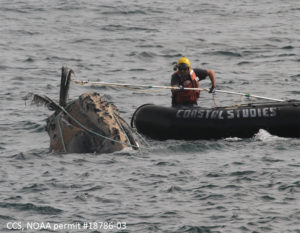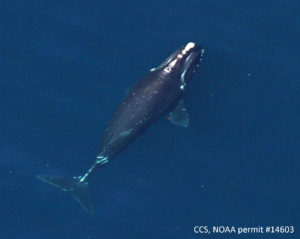
Maine lobstermen have withdrawn their support for an agreement made last April to protect whales by limiting the amount of rope they use, and Cape Cod lobstermen are not happy.
Severely endangered right whales are thought to become tangled in the ropes connecting buoys to lobster traps set on the ocean floor, leading to increased mortality. But Maine lobstermen claim that the science at the basis of the agreement doesn’t add up.
Mass. Lobstermen’s Association Executive Director Beth Casoni said that lobstermen on Cape Cod are frustrated by Maine’s withdrawal. Cape lobstermen have taken action on right whale conservation by refraining from winter lobstering and by experimenting with innovative techniques to limit rope use. But their efforts go to waste when the whales end up entangled farther north, Casoni said.
“This discussion makes a lot of fishing industry people upset,” said Scott Landry of Provincetown’s Center for Coastal Studies. “But in our minds this is not an attack on a fishery. It’s a battle against rope.” Landry directs the center’s Marine Animal Entanglement Response program.
Right whales visit Cape Cod Bay in winter. In 2014 an annual closure was adopted, banning trap fishing in Cape Cod’s coastal waters for three months each winter.
Since the rule was put in place, Landry said, the number of right whales entangled in fishing gear from Cape Cod Bay has dropped. Entangled right whales have shown up in Cape Cod Bay, but researchers believe the rope involved likely comes from elsewhere.
The closure has affected the livelihoods of Cape lobstermen. “People’s earnings have been restricted to nine months instead of twelve, when they could have gone out in February, March, and April,” Casoni said. “At that time of year, the price is high because there’s not a big supply.”
She said that Cape Cod lobstermen have been willing to adapt and compromise. “We usually work well with Maine, but now they’re saying, ‘It’s not our problem.’ It’s not that they can’t. They just don’t want to. It’s very disheartening.”
Questioning the science
In April of this year the National Oceanic and Atmospheric Administration’s Atlantic Large Whale Take Reduction Team, with representatives of the sciences, fisheries industry, and government, agreed to reduce the amount of rope used in fishing along the East Coast to curtail right whale deaths.
The group also decided to improve rope markings, so that when an animal is found wrapped in ropes and nets the gear’s origin can be identified. Currently about 70 percent of the rope entangling right whales cannot be identified.
But Maine contests the conclusion that lobster rope is leading to right whale deaths.
Maine Lobstermen’s Association (MLA) Executive Director Patrice McCarron did an independent analysis of right whale mortality data.
“MLA’s analysis found that gillnet and netting gear … were the least prevalent in right whale entanglements from known causes. This finding means the conservation target … is unsupported by the best available data,” McCarron wrote.
McCarron also argued that right whale entanglements in lobster gear have been decreasing in recent years, suggesting that current strategies are working and new regulation is not required.
Maine’s congressional delegation is involved as well. In a July letter to President Trump, Senators Susan Collins and Angus King Jr., along with members of the House, argued that the connection between Maine’s $1 billion lobster industry and right whale deaths has not been sufficiently proved to justify regulation.
“Your administration has made a point of targeting regulations that you believe are ill-conceived or overly burdensome,” the letter states. “NOAA is pushing forward with the development of new regulations that will force significant economic hardship on Maine lobstermen without clear evidence that these regulations will have a positive impact on whale conservation efforts.” The letter also points out that many whale deaths have taken place in Canada.
Both letters highlight uncertainties in right whale entanglement scientific studies.
There are two main issues obscuring a clear picture of why whales get entangled. The first is that right whales have a large range.
“Whales can carry gear from Canada to Florida,” Landry said, adding that the location of death does not necessarily relate to the site of entanglement. A whale found dead in Canada may have been entangled initially in Maine or farther south.
Second, most gear found on whales is unmarked, making it difficult to identify where the whale was initially entangled.
But some things are certain.
A recent study suggests that, despite mitigation efforts, right whale deaths due to entanglement continue to rise. The researchers found that the most common known cause of right whale death is entanglements, which have increased from 21 percent of right whale mortalities in 1970-2002 to 51 percent in 2003-2018. In total, 70 right whales have died in the past 20 years.
Although there are some uncertainties, Landry thinks the science is convincing. On an even more basic level, “If you believe the entanglement problem is a mix of whales and rope, if there is no rope, there cannot be an entanglement problem,” Landry said.

Why all the fuss about right whales?
Landry said that rope entanglements are killing endangered right whales each year at a rate much higher than is acceptable for the species’ dwindling population. While the population of right whales has increased since 1997, when there were only 295 whales, they are seriously threatened with extinction, with fewer than 400 individuals today.
Even one right whale killing a year by humans is too many. To maintain the population, fewer than 0.6 kills per year is permitted.
The numbers have remained high, though; 10 have already died this year. Although the number may seem small, it’s a large percentage of the total population.
Whales and other animals, like sea turtles and seals, often become entangled in rope or other fishing gear while swimming through coastal waters. Due to their large size (right whales weigh up to 50 tons), whales often don’t drown when first entangled. Instead, they carry the rope with them.
Dying by entanglement is a slow, painful death. The rope and netting slowly cut into the animal, “sawing into the whale’s body, opening it up to infection, keeping it from feeding, so it slowly declines in health,” Landry said. “It’s horrible way to die.”
Right whales are important for their ecosystems. Brian Sharp, marine mammal rescue and research director at the International Fund for Animal Welfare, said that beyond the intrinsic value of species diversity, whales act as “nitrogen pumps. After they feed and come up to the surface, they defecate, which fertilizes the ocean for plankton,” the basis of the food chain, Sharp said.
Massachusetts lobstermen are experimenting with ropeless fishing techniques, like floats that deploy when a ship sends down an acoustic signal to a trap, or ropes that break more easily, Sharp said. Although they haven’t been wildly successful, these attempts, along with the annual closure, point to a general desire in the community to preserve the species.
Casoni noted that the lobster industry is slowly returning to its roots. “Before, [lobstermen] would use small boats and skiffs and cotton twine,” she said. “They were out there with their rag ropes.”
These days, lobstermen use steel and plastic ropes. “It’s almost like we came to the highest point of efficiency, then we realized we need to back off a bit,” Casoni said. “Now we’re going back.”



